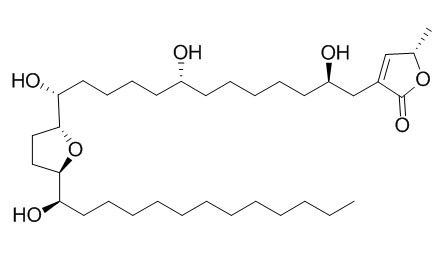Annonacin
| Catalog No. | CFN97856 |  |
| CAS No. | 111035-65-5 | |
| Molecular Weight: | 596.89 | |
| Molecular Formula | C35H64O7 | |
| DBs | [PubChem]:274952641 [ChEMBL]: [PCIDB]:43268 |
Standard InChI:
Biological Activity
Annonacin, a natural lipophilic mitochondrial complex I inhibitor, can increase phosphorylation of tau in the brain of FTDP-17 transgenic mice, and induce nigral and striatal neurodegeneration in rats: possible relevance for atypical parkinsonism in Guadeloupe.[1,2]
Annonacin in Asimina triloba fruit has neurotoxicity, more toxic than rotenone to mesencephalic neurons.[3]
Annonacin has cytotoxicity , it can activate p21 in a p53-independent manner and arrested T24 cells at the G1 phase, induce Bax expression, enhance caspase-3 activity, and cause apoptotic cell death in T24 cells, suggests that annonacin is potentially a promising anti-cancer compound.[4]
Annonacin induces cell cycle-dependent growth arrest and apoptosis in estrogen receptor-α-related pathways in MCF-7 cells.[5]
Product
References
[1] Yamada E S, Respondek G, Müssner S, et al. Exp Neurol, 2014, 253:113-25.
[2] Champy P, Höglinger G U, Féger J, et al. J Neurochem, 2004, 88(1):63–9.
[3] Potts L F, Luzzio F A, Smith S C, et al. Neurotoxicology, 2012, 33(1):53-8.
[4] Yuan S S F, Chang H L, Chen H W, et al. Life Sci, 2003, 72(25):2853-61.
[5] Ko Y M, Wu T Y, Wu Y C, et al. J Ethnopharmacol, 2011, 137(3):1283-90.
[6] Sun L, Yu J G, Li D Y,et al. Pharm J, 2001, 36 (09): 153-8.





